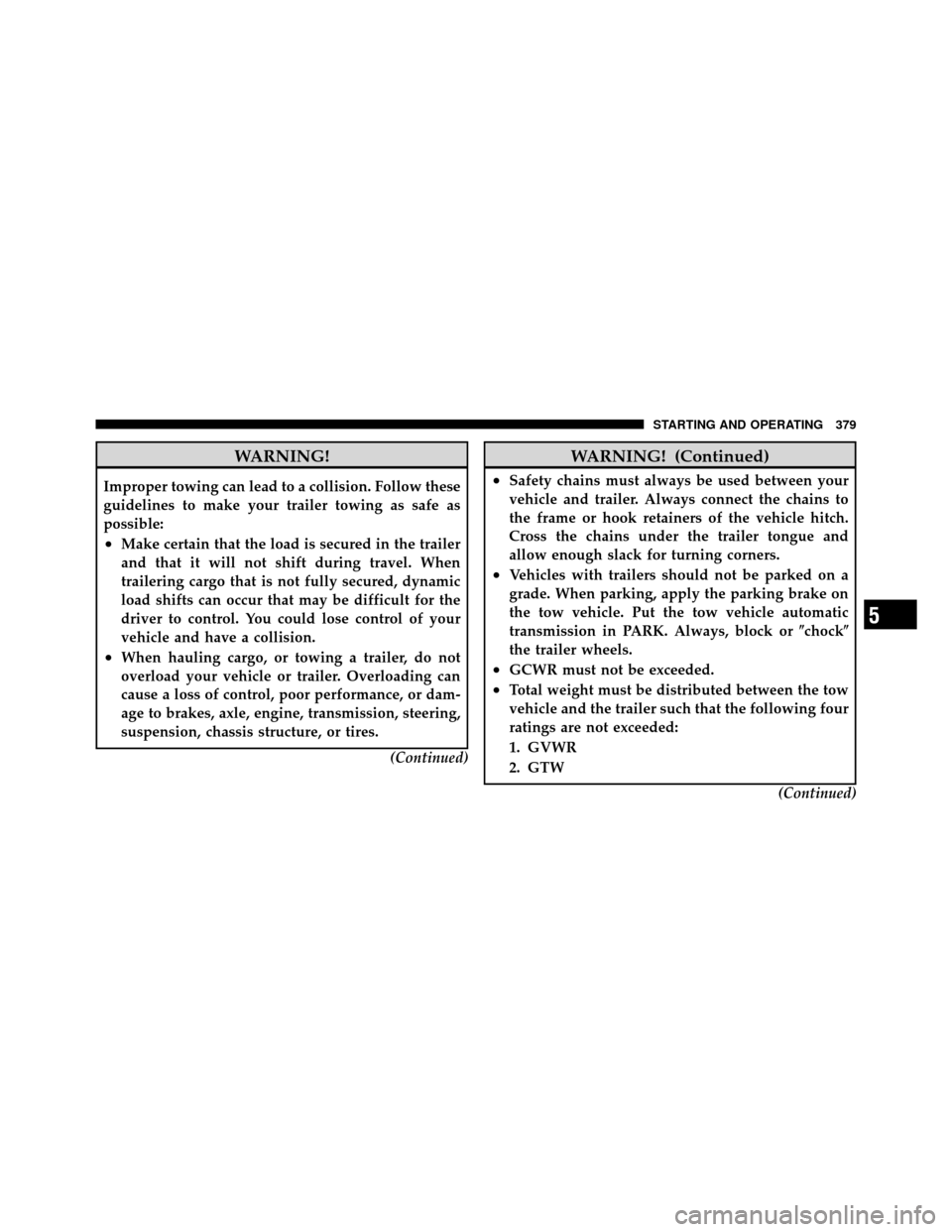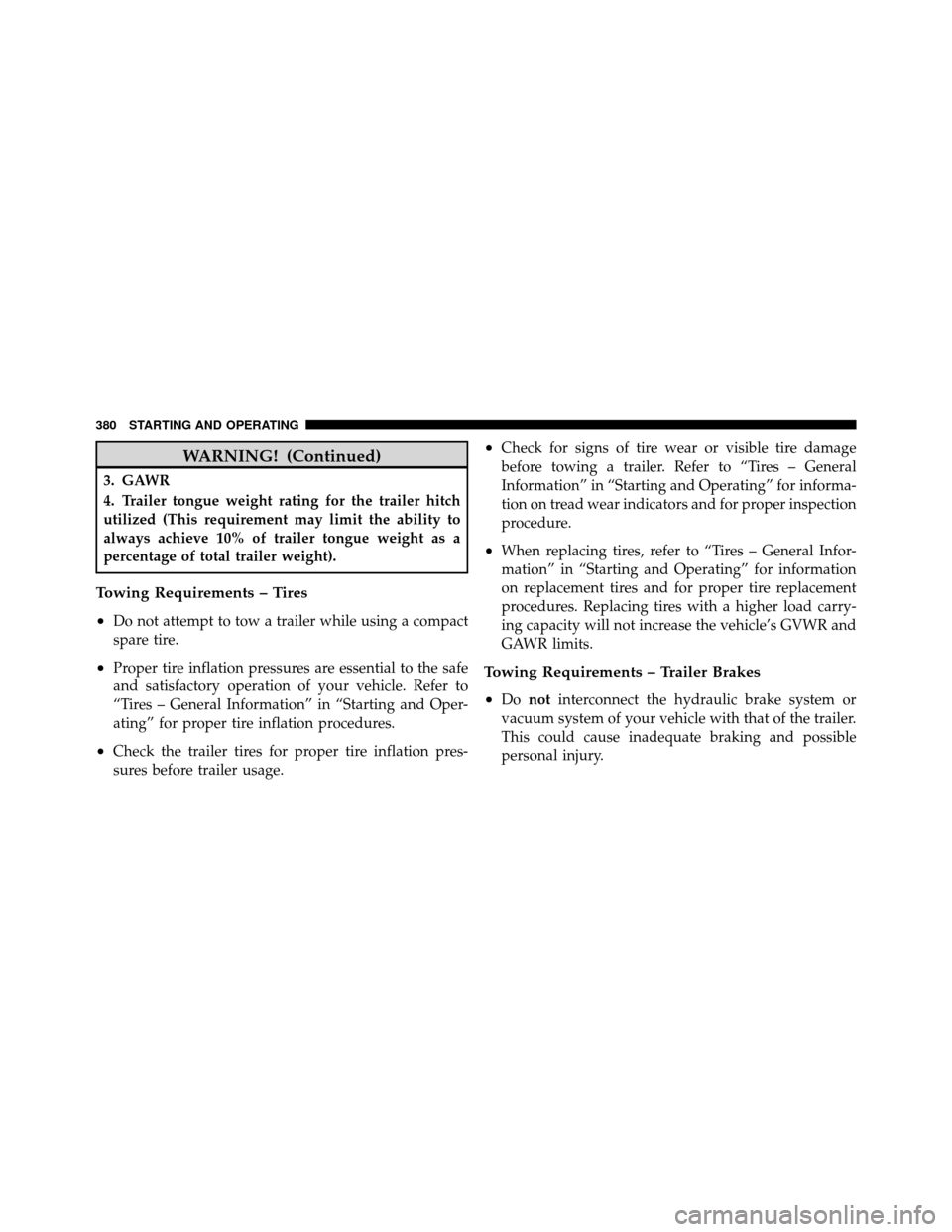Page 379 of 508
CAUTION!
Towing a trailer with a larger than recommended
frontal area could cause the engine to overheat or
cause severe engine damage under extreme condi-
tions.
Trailer And Tongue Weight
Always load a trailer with 60% to 65% of the weight in
the front of the trailer. This places 10% of the Gross Trailer
Weight (GTW) on the tow hitch of your vehicle. Loads
balanced over the wheels or heavier in the rear can cause
the trailer to swayseverelyside to side which will cause
loss of control of vehicle and trailer. Failure to load
trailers heavier in front is the cause of many trailer
collisions.
Never exceed the maximum trailer tongue weight
stamped on your bumper or trailer hitch. Consider the following items when computing the
weight on the rear axle of the vehicle:
•The trailer tongue weight of the trailer.
•The weight of any other type of cargo or equipment
put in or on your vehicle.
•The weight of the driver and all passengers.
5
STARTING AND OPERATING 377
Page 380 of 508

NOTE:Remember that everything put into or on the
trailer adds to the load on your vehicle. Also, additional
factory-installed options, or authorized dealer-installed
options, must be considered as part of the total load on
your vehicle. Refer to “Tire Safety Information/Tire and
Loading Information Placard” in “Starting and Operat-
ing” for the maximum combined weight of occupants
and cargo for your vehicle.
CAUTION!
Incorrect trailer tongue weight could result in in-
creased yaw or vehicle instability. A negative trailer
tongue weight could unload the rear suspension of
the tow vehicle decreasing vehicle stability. Negative
trailer tongue weight could cause the trailer to squat
and potentially become disengaged from the tow
vehicle resulting in a runaway trailer condition.
Towing Requirements
To promote proper break-in of your new vehicle drive-
train components the following guidelines are recom-
mended:
CAUTION!
•Do not tow a trailer at all during the first 500 miles
(805 km) the new vehicle is driven. The engine,
axle or other parts could be damaged.
•Then, during the first 500 miles (805 km) that a
trailer is towed, do not drive over 50 mph
(80 km/h) and do not make starts at full throttle.
This helps the engine and other parts of the
vehicle wear in at the heavier loads.
378 STARTING AND OPERATING
Page 381 of 508

WARNING!
Improper towing can lead to a collision. Follow these
guidelines to make your trailer towing as safe as
possible:
•Make certain that the load is secured in the trailer
and that it will not shift during travel. When
trailering cargo that is not fully secured, dynamic
load shifts can occur that may be difficult for the
driver to control. You could lose control of your
vehicle and have a collision.
•When hauling cargo, or towing a trailer, do not
overload your vehicle or trailer. Overloading can
cause a loss of control, poor performance, or dam-
age to brakes, axle, engine, transmission, steering,
suspension, chassis structure, or tires.(Continued)
WARNING! (Continued)
•Safety chains must always be used between your
vehicle and trailer. Always connect the chains to
the frame or hook retainers of the vehicle hitch.
Cross the chains under the trailer tongue and
allow enough slack for turning corners.
•Vehicles with trailers should not be parked on a
grade. When parking, apply the parking brake on
the tow vehicle. Put the tow vehicle automatic
transmission in PARK. Always, block or �chock�
the trailer wheels.
•GCWR must not be exceeded.
•Total weight must be distributed between the tow
vehicle and the trailer such that the following four
ratings are not exceeded:
1. GVWR
2. GTW
(Continued)
5
STARTING AND OPERATING 379
Page 382 of 508

WARNING! (Continued)
3. GAWR
4. Trailer tongue weight rating for the trailer hitch
utilized (This requirement may limit the ability to
always achieve 10% of trailer tongue weight as a
percentage of total trailer weight).
Towing Requirements – Tires
•
Do not attempt to tow a trailer while using a compact
spare tire.
•Proper tire inflation pressures are essential to the safe
and satisfactory operation of your vehicle. Refer to
“Tires – General Information” in “Starting and Oper-
ating” for proper tire inflation procedures.
•Check the trailer tires for proper tire inflation pres-
sures before trailer usage.
•Check for signs of tire wear or visible tire damage
before towing a trailer. Refer to “Tires – General
Information” in “Starting and Operating” for informa-
tion on tread wear indicators and for proper inspection
procedure.
•When replacing tires, refer to “Tires – General Infor-
mation” in “Starting and Operating” for information
on replacement tires and for proper tire replacement
procedures. Replacing tires with a higher load carry-
ing capacity will not increase the vehicle’s GVWR and
GAWR limits.
Towing Requirements – Trailer Brakes
•
Donot interconnect the hydraulic brake system or
vacuum system of your vehicle with that of the trailer.
This could cause inadequate braking and possible
personal injury.
380 STARTING AND OPERATING
Page 495 of 508

GaugesCoolant Temperature .................. 194
Fuel .............................. 194
Odometer .......................... 198
Tachometer ......................... 198
Gear Ranges ........................ 300,308
Gear Select Lever Override ................. 403
General Information ................. 18,130,360
General Maintenance ..................... 414
Glass Cleaning .......................... 443
Gross Axle Weight Rating ...............372,374
Gross Vehicle Weight Rating .............372,373
GVWR ............................... 372
Hands-Free Phone (Uconnect™) ............. 100
Hazard Driving Through Flowing, Rising, or Shallow
Standing Water ...................... 317
Hazard Warning Flasher ................... 386 Head Restraints
......................... 141
Headlights ............................ 450
Bulb Replacement .................... 450
Cleaning ........................... 441
High Beam ...................... 152,207
High Beam/Low Beam Select Switch ...... 152
On With Wipers ..................... 159
Passing ............................ 153
Replacing .......................... 450
Switch ............................ 150
Heated Seats ........................... 137
Heater ............................... 275
Heater, Engine Block ..................... 297
Hitches Trailer Towing ....................... 375
HomeLink® (Garage Door Opener) Transmitter . . 164
Hood Prop ............................ 148
Hood Release .......................... 148
10
INDEX 493
Page 504 of 508

Quality Grading..................... 483
Radial ............................ 344
Replacement ........................ 349
Rotation ........................... 351
Safety .......................... 332,341
Sizes ............................. 333
Snow Tires ......................... 351
Spare Tire .......................... 388
Spinning ........................... 347
Tread Wear Indicators ................. 348
Tongue Weight/Trailer Weight .............. 377
Towing ............................... 373
24-Hour Towing Assistance ............. 114
Disabled Vehicle ..................... 404
Guide ............................. 376
Recreational ........................ 383
Weight ............................ 376
Towing Assistance ....................... 114
Traction .............................. 317 Trailer Towing
.......................... 373
Cooling System Tips .................. 383
Hitches ............................ 375
Minimum Requirements ................ 378
Trailer and Tongue Weight .............. 377
Trailer Towing Guide ..................... 376
Trailer Weight .......................... 376
Transaxle Automatic ....................... 12,294
Autostick .......................... 315
Selection of Lubricant ................. 457
Transmission Automatic ....................... 297,435
Filter ............................. 438
Maintenance ........................ 435
Transmitter Battery Service
(Remote Keyless Entry) .................... 26
Transmitter Programming
(Remote Keyless Entry) .................... 25
502 INDEX
Page:
< prev 1-8 9-16 17-24